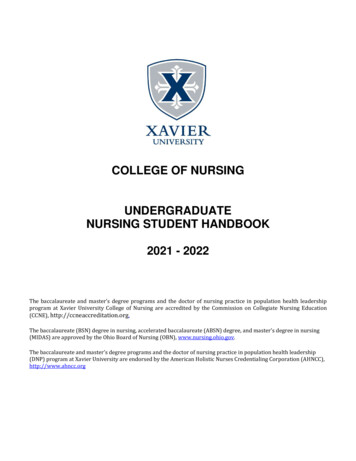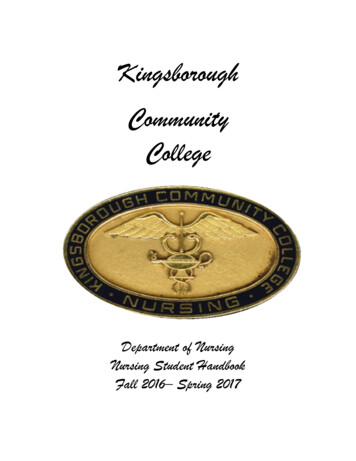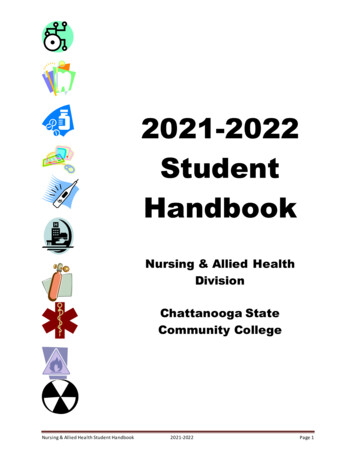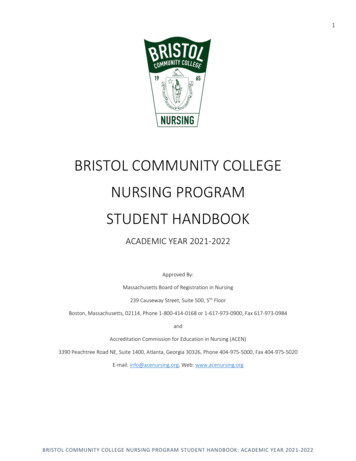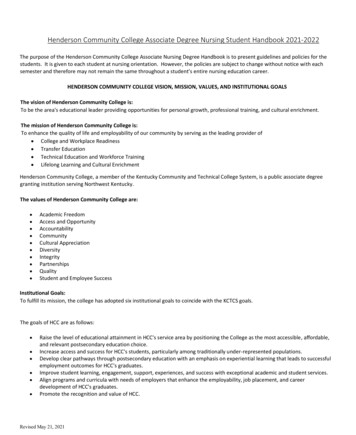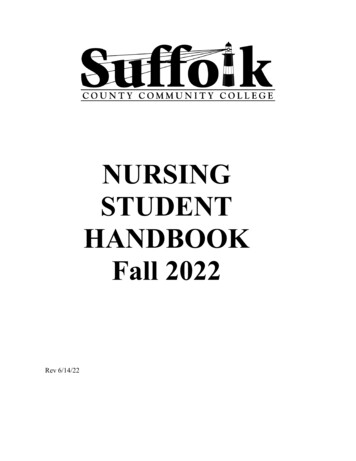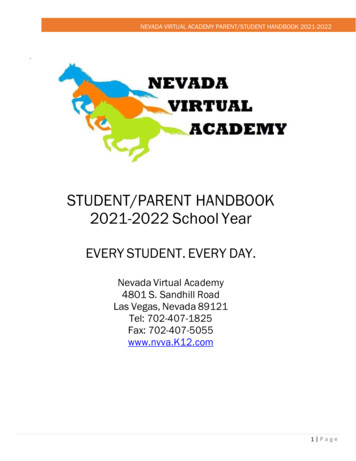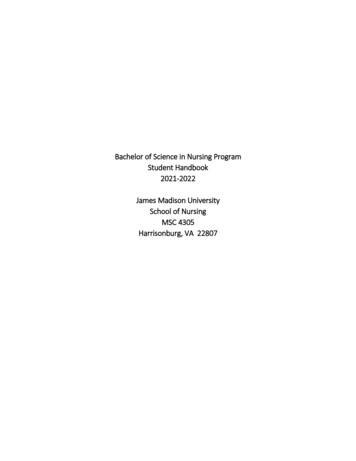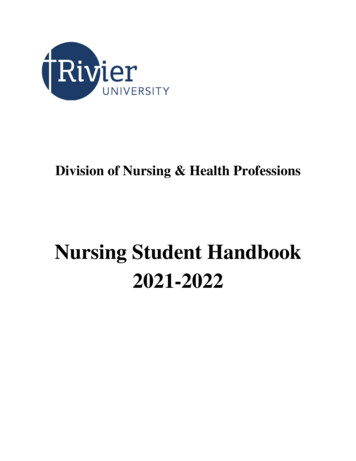
Transcription
Division of Nursing & Health ProfessionsNursing Student Handbook2021-2022
September 2021Dear Students,On behalf of the Division of Nursing & Health Professions faculty and staff, I would like towelcome you, our new and returning nursing students, to a year of new experiences andprofessional growth at Rivier University.You will see and experience many changes this fall. More change will be forthcomingthroughout the year. Nursing faculty are committed to guiding students’ learning and toproviding challenging experiences which will serve our graduates well as they enter the richlyrewarding, dynamic and rapidly-evolving healthcare environment.Nursing and Health Professions faculty view our students as future professional colleagues andtherefore expect students to conduct themselves in a professional manner on campus, in theclassroom regardless of learning modality and within the clinical area. We encourage nursingstudents to review the “Professionalism” guidelines in this student nurses’ handbook (p. 16).The Student Nurses Association (SNA) at Rivier University is an active student group whichoffers many opportunities for student participation in health fairs, blood drives, healthscreenings, and community outreach. These, and other activities offered through the RivierNursing Wellness Connection, will enrich your experiences here at Rivier while enhancing yourprofessional growth.Best wishes to each and every one of you as you enjoy this academic year.Sincerely,Paula J. Williams, Ed.D., RNDeanDivision of Nursing & Health Professionsii
Nursing & Public Health Faculty 2021-2022Dean: Paula J. Williams, Ed.D., RNDirector, Undergraduate Nursing Education: Judi O’Hara, Ed.D., RNDirector, Graduate Nursing Education: Donna Proulx, Ph.D., RN, CCRN-CSCDirector, Doctoral Nursing Education: Donna Proulx, Ph.D., RN, CCRN-CSCDirector, Public Health Programs: Christina Griecci, Ph.D., MPHFacultyColleen Baldwin, MS, RNStephanie Ballentine, MS, APRN, FNP-BCHolly Bergeron, MS, RNTania Centra, RN, MSN, APRNCatherine Fogg, Ph.D., APRNPamela Forcier, MSN, RN, VA-BCDeborah Gebhardt, MSN, APRN, FNP-BCKimberly Giddings, MS, RN, PCCNTracy Hardy, DNP, MS, APRN, FNPJennifer Limongiello, Ph.D., FNP-BCJanice Lindquist, MS, RNCynthia Ludwick, APRN, PMHNP-BCMelinda Luther, DNP, MS, RN, CNEKatelyn McDonough, MS, RNSarah Phillips, MS, MPHCathy Prevost, MS, RN, PCCNRegina Ruotolo, MSN, RNHeather Schaufenbil, MSN, RNCynthia Tremblay, MS, CNSAnna Wendel, Ph.D., CRNPKaren Zanni, Ph.D., FNP-BCMichael Zoltko, MSN, APRN, FNP-BC, PMHNP-BCFaculty EmeritusDenise Baxter, Ed.D., APRN, FNP, CNEMary Ann Breen, MS, RN, M.Ed.Grace Sullivan, DNS, APRNSenior LecturersBarbara Dunn, MS, RNJohn Foley, PharmDMark C. Hand, Ph.D., RN, CNEResource Center DirectorMelissa Bodi, BSN, RNResource Center CoordinatorTBAiii
Table of ContentsIntroduction . 1Section 1Mission/Purpose/Philosophy . 1Organizing Framework. 3Student Learning Outcomes . 4DNHP Resource Center. 9Student Success . 9Professional Standards for Nursing . 9Ethical Behavior . 10Academic Student Participation Opportunities . 10Achievement Tests . 13Clinical Assignments. 13Clinical/Practicum Requirements . 13Penalties for Non-Compliance . 13Confidentiality Statement . 14COVID-19 Statement1 . 15CPR Certification Statement . 15Criminal Background Check . 15Drug Screening . 15Health Insurance . 15Identification Cards . 16Liability Insurance. 16Professionalism . 16Requirements for Licensure . 17Standard Precautions . 17Unit of Credit . 17Hazardous Waste . 18Weather & Emergency Closings . 19Section 2 - Undergraduate Pre-licensure PoliciesATI RN Comprehensive Predictor Exam . 21Attendance. 24Clinical Make-up . 27Medication Competency. 28Conduct (Clinical and Classroom) . 29Dismissal . 31Dress Code and Personal Appearance . 32Evaluation . 34Examination . 35Leave of Absence and Illness . 36Notification of Change in Residence . 37Proctored Exam - ATI . 38Progression/Retention/Graduation . 40Readmission . 42Science Grade . 44Student Signature . 45Withdrawal . 46Written Notice . 47Section 3 - Undergraduate Post-licensure PoliciesAttendance. 49Dismissal . 50Evaluation . 51iv
Table of Contents (continued)Progression/Retention/Graduation . 52Readmission . 53RN-BS Online Course Registration. 54Written Notice . 55Section 4 - Graduate Nursing PoliciesAcademic Notice Policy . 57Admissions Portfolio Policy . 58Applying for Post-Master’s Certificate Program. 59Attendance Policy . 60Grievance - Academic . 61Informed Consent . 63Notification of Change in Residence . 64Practicum Placement Policy . 65Practicum Placement: Alternative Nurse Practitioner Clinical Practicum Placement . . 67Program of Study Change . 69Progression, Retention, Dismissal Policy . 70Readmission Policy . 71Standard Precautions . 73Student Signature . 74Transfer of Credit Policy . 75Withdrawal/Leave of Absence . 76Section 5 – Doctor of Nursing Practice (DNP) PoliciesAcademic Notice Policy . 79Attendance Policy . 81Grievance - Academic . 82Maintaining Professional Licensure . 84Practicum Course Policy . 85Progression, Retention, Dismissal . 87Readmission . 88Student Scholarly Project- Scholarly Project Team . 90Transfer of Credit . 91Withdrawal or Leave of Absence . 92Student Signature Page . 94All Nursing programs are fully accredited by theAccreditation Commission for Education in Nursing, Inc. (ACEN)3390 Peachtree Road NE, Suite 1400Atlanta GA 30326(404)975-5000; www.acenursing.orgn:\Nursing Student Handbook\2021-2022v
IntroductionThe Division of Nursing & Health Professions (DNHP) at Rivier University has prepared students to meet the rapidlychanging demands of the healthcare environment for almost three decades. Rivier University continually builds on itsstrengths, offering programs that provide students with individual attention, a quality education, and numerousopportunities for applying classroom theory to clinical practice. DNHP offers four undergraduate options: a part-timeevening Associate of Science Degree, an LPN-ASN, a full-time, four-year Bachelor of Science Degree, and a flexibleonline RN-BS option for registered nurses. The program also offers graduate education in advanced clinical family andpsychiatric nursing, nursing education, nursing leadership, and Doctor of Nursing Practice (DNP). Current professionalstandards are reflected in the learning competencies /outcomes, which move from simple to complex and are incrementaland reinforced throughout the programs. The curriculum and instructional processes reflect education and nursing theorythroughout all levels of programs. Coherent organization of the curriculum integrates general education with nursingtheory and practice. Nursing education has grown through innovation and the DNHP emphasizes flexible high-qualityprograms that are the cutting edge.The Nursing Student Handbook is published annually as a reference guide for all nursing students at Rivier University.The information is accurate at the time of publication. The University and the Division of Nursing & Health Professionsreserves the right to make necessary changes as needed with prompt notification of changes to the students. Each studentis responsible for knowing and understanding the information contained in the handbook. Adherence to guidelines is aresponsibility shared by students, faculty and administrators. In addition to the policies outlined in this handbook, nursingstudents must adhere to Rivier University policies as published in the Rivier University Academic catalog and the RivierUniversity Student Handbook. Students enrolled in online courses should also refer to the Rivier Online StudentHandbook.Purpose/MissionThe Division of Nursing & Health Professions at Rivier University, in accordance with the mission of Rivier University,regards as its purpose the education of individuals who seek flexibility in the educational process and career mobility innursing. The Division prepares its graduates to care for all persons with respect, valuing their personal worth and dignity.In pursuit of academic excellence, the Division bases its curriculum on a strong foundation of science and liberal arts.The Division prepares its graduates for practice at the associate, baccalaureate, master’s and doctoral degree levels innursing.PhilosophyFaculty recognize each person as a unique combination of mind, body, and soul and are committed to caring for personsfrom conception through death. Caring is essential in the faculty-student relationship and in students’ relationships withothers throughout the program. The concept of caring permeates the curricula. Caring is viewed as a total way of being,relating, and acting (Watson, 1988). The functional and ethical manifestations of caring include “compassion,competence, confidence, conscience, commitment and comportment” (Roach, 2002), as explained in Table 1. Caring1
reflects the qualities of engagement with, and investment in, another person and is the essence of nursing practice. Caringwithin the profession of nursing involves the formation of a holistic value system, the development of sound clinicaljudgment, and the therapeutic use of mentConscienceComportmentTable 1. Explanation of the Components of Caring (Roach, 2002)ExplanationThe ability to understand and share in people's experiences, and to exhibit a sensitivityand responsiveness to others (Roach, 2002). Compassion is discussed, modeled, nurtured,and expected throughout the curriculum. Compassion and competence are indispensableattributes of the caring nurse.The unified application of knowledge, judgment, skills, energy, experience, andmotivation required by the profession of nursing (Roach, 2002). Nursing process is themethodology used to organize nursing practice, and expertise in its application developsacross the curriculum.A quality that fosters mutual trust and respect between client and nurse (Roach, 2002). Asstudents’ knowledge and skills develop, they grow in confidence and in their ability todevelop a trusting and therapeutic nurse-client relationship.Convergence between one's desires and one's obligations, with a deliberate choice to actin accordance with the roles and responsibilities of the professional nurse in relation tooneself and others (Roach, 2002).A state of moral awareness (Roach, 2002). Conscience grows out of experience and aprocess of valuing self and others. Professional caring demands that our moral awarenessbe fine-tuned by knowledge and moral inquiry.A manner of bearing, demeanor, language, and dress that is in harmony with respect andcaring for the individual patient (Roach, 2002). It reflects self-respect and serves torepresent the profession as a whole to others.The traditional metaparadigm of nursing incorporates four key attributes: person, health, environment, and nursing.Nursing is the professionalism of the human capacity to care. Nursing is a profession that can be learned by intentionalexposure to selected information, experiences, and skills, as well as the examples of faculty and other nurses. Through atherapeutic human care process, nurses assist individuals and families in attaining optimal levels of health, comfort, andadaptation. Nursing practice incorporates knowledge, attitudes, and skills from the science of nursing, the humanities,biological sciences, behavioral sciences and theology to provide care across the lifespan within the context of the nursingprocess. In addition, nursing is a transcultural phenomenon requiring specialized knowledge and skill to provide care thatis congruent with a person’s lifestyle, social structure, and environment.A person is a unique multi-dimensional being possessing a mind, body, and soul. A person grows, develops, and learnsthrough interactions with the internal and external environments across the lifespan. Each person has unique pastexperiences, events, and relationships that have potential for influencing present and future behavior. Persons strive toestablish harmony within themselves and in their interactions with their environments.2
Health is a continuous, dynamic, and evolving process of adapting, coping, and growing. Health exists along acontinuum in the mind, body, and soul of a person. It is further affected by developmental processes, culture, beliefs,attitudes, choices, and lifestyles that evolve from and then are reflected in their interactions with the environment.The environment is a dynamic multi-dimensional field of continuous reciprocal interaction within which a person livesand develops. The concept of environment incorporates both internal and external forces that influence individuals,families, and communities. It includes subjective and objective perceptions as the person engages with opportunities andhazards for human health. Various aspects of the environment may be altered intentionally or unintentionally by humanbehavior.Nursing education is an aspect of higher education that seeks to share a broad base of knowledge, skills, and attitudeswith students who want to learn and practice professional nursing. Through intentionally designed, outcome-orientednursing education experiences, students’ learning occurs through active participation, discovery, modeling, dialogue,practice, and affirmation. The cultivation of personal, societal, and spiritual value systems enhances a student’stherapeutic use of self, critical thinking, and caring potential. The pursuit of life-long learning is encouraged andsupported.Organizing FrameworkThe faculty of the Division of Nursing & Health Professions believes that nursing practice is the professionalization of thehuman capacity to care. The organizing framework reflects the philosophy of the faculty of the Division of Nursing &Health Professions. The curriculum is designed and organized to assist the students to attain specific learning outcomes.Learning opportunities integrate the biological sciences, behavioral sciences, and the humanities with concepts of caringand nursing theory to provide a foundation for providing nursing care. The faculty utilizes an outcome-specific approachusing the six competency categories for all nursing programs identified by QSEN (Quality and Safety Education forNurses, www.qsen.org/competencies, (2012). The competency categories are patient-centered care, teamwork andcollaboration, evidence-based practice, quality improvement, safety, and informatics.The competency categories have been used by faculty to derive end-of-program and related end-of-course studentlearning outcomes. The resulting nursing education curriculum provides the basis for description, explanation, andprediction of human needs and behavior and the foundation for incremental nursing education across the curriculum.Figure 1 illustrates the components of the nursing education curriculum beginning with the faculty’s philosophy, a broadfoundation of concepts from the arts and sciences, the principles of caring, the metaparadigm of nursing, professionalnursing guidelines, the QSEN competencies, and the end-of-program student learning outcomes.3
Figure 1. The Components of the Organizational Framework for the Nursing Education CurriculumThe ultimate goal of nursing education is to prepare the student to think critically, communicate accurately, and performappropriate therapeutic nursing interventions in patient care situations; integrate caring behaviors with nursing actions;incorporate an ethical perspective in clinical decision making, and function effectively as a team member within theorganizational structures surrounding the delivery of safe patient-centered care.Outcomes – Undergraduate Degree in NursingThe Division of Nursing & Health Professions Program Outcomes seek to advance student knowledge regardingevidenced based professional nursing practice, encouraging students to continue to pursue advanced education, formallyand informally. All DNHP Program Outcomes are based on all professional organizations listed in this handbook onPage 8. The curriculum is designed to develop student’s knowledge and skill sets within the six competencies. Currenttrends in healthcare are reflected within these competencies and are consistent with the mission of Rivier University andthe ANA Code of Ethics.The integration of the core concepts, supporting concepts, (Roche, 2002; Watson, 1988) and competencies provides thebasis for description, explanation, and prediction of human behavior and the foundation for nursing activities in thecurriculum. Caring is viewed as a total way of being, relating, and acting and reflects the qualities of engagement with,and investment in another person, which is the very essence of nursing practice. Caring within the profession of nursinginvolves the formation of a holistic value system, the development of sound clinical judgment, and the therapeutic use ofself. In essence, nursing is both the professionalization and the application of the human capacity to care (Watson, 1988).Student Learning Outcomes – Associate of Science Degree in NursingGraduates of the Associate of Science Degree Program in Nursing are prepared to function as beginning practitioners instructured health care agencies using established protocols. Graduates are eligible to take the National Council LicensureExamination for Registered Nurses (NCLEX-RN) and are prepared to:4
Provide patient-centered, priority-based nursing care with sensitivity and respect for the diversity of the humanexperience through application of the nursing process. Demonstrate effective use of technology and standardized practices that support safe practice. Base individualized care on best current evidence, patient values, and clinical experience. Apply technology and information management tools to support processes of caring and evaluate impact onpatient outcomes. Function as a member of the healthcare team, utilizing moral, ethical, and humanistic principles. Recognize that nursing and other health professions are parts of systems of care and care processes that affectoutcomes for patients and families.Student Learning Outcomes – Bachelor of Science Degree in NursingGraduates of the Bachelor of Science Degree Program in Nursing are prepared to function as generalists who practiceprofessional nursing in a variety of health care settings, are prepared to pursue graduate studies, and are prepared to: Provide patient-centered, priority-based nursing care to individuals, families, and groups through independentand collaborative application of the nursing process. Implement factors that create a culture of safety and a just culture. Integrate evidence, clinical judgment, inter-professional perspectives, and patient preference in planning,implementing, and evaluating outcomes of care. Incorporate the use of technology that supports clinical decision making, patient education, error prevention, andcare coordination. Use inter- and intra-professional communication and collaborative skills to deliver evidence-based, patientcentered care. Participate in the use of quality indicators and core measures to evaluate the effect of change in the delivery ofcare as derived through health policy.Student Learning Outcomes - MS Degree Program in NursingThe MS curriculum is designed to provide a foundation of philosophical, ethical and scientific knowledge which providesfor the functional and ethical manifestations of caring, and upon which the competencies of advanced practice rest. Inaddition to the nursing theorists of Watson (1988), Roach, (2002), Benner (1984), Brykczynski (1985), the educationaltheories of Knowles Adult Learning Theory (2005), Blooms (1956), Anderson (1995), and Boyer (1990) guide theinstructional processes.5
The graduate faculty use Benner’s (1984) framework as modified by Brykcznski (1985) as set forth in the curriculumguidelines published by the National Organization of Nurse Practitioner Faculties (NONPF). These modifications reflectadvanced nursing practice by replacing the Diagnostic and Monitoring Function and Administering and MonitoringTherapeutic Interventions and Regimens with a single domain of Management of Patient Health/Illness in AmbulatoryCare Settings. Graduates of the Family Nurse Practitioner and Psychiatric Mental Health Nurse Practitioner tracks arequalified to sit for national certification exams in their respective areas.Additionally, the graduate faculty acknowledge the importance of Knowles (2005) framework in that the adult learner ismore of an independent, self-directed learner who has accumulated a growing reservoir of previous experience that servesas a rich resource for learning. In addition, as Knowles identifies, the perspective of time changes from one of postponedapplication of knowledge to one of immediate application; there is a shift in orientation of learning to being problemcentered rather than subject centered. Graduates of the Master of Science Degree Program in Nursing are prepared tofunction as advanced practice nurses in various settings. Graduates of the Nurse Educator track are qualified to sit for theNational League for Nursing Certified Nurse Educator Exam (CNE) once the te
The Nursing Student Handbook is published annually as a reference guide for all nursing students at Rivier University. The information is accurate at the time of publication. The University and the Division of Nursing & Health Professions reserves the right to make necessary changes as needed with prompt notification of changes to the students.
